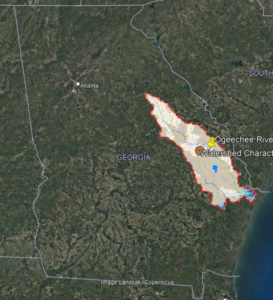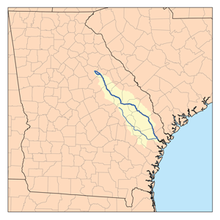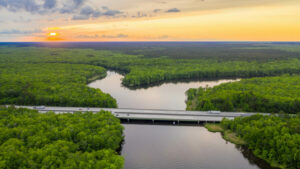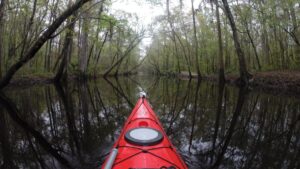
The Ogeechee Watershed is approximately 5000 square miles, with many tributaries and runoffs flowing into the main Ogeechee River. The river itself starts in the eastern part of the Piedmont region, flowing past Statesboro and ending in the Ossabaw Sound. Like the Flint River, it is also one of the only free flowing rivers above 200 miles in the United States. The area is interspersed with pine forests as is typical with the coastal plain region, as well as being marked by agricultural land which is also very common in this region.

The main part of the river is in the coastal plain, but more on the eastern side in comparison with the location of the Kolomoki mounds. According to the EPA, rivers in the Coastal Plain region “meander broadly across flat plains created by river deposition and form complex wetland topographies, with natural levees, back swamps, and oxbow lakes. Typically, they drain densely vegetated watersheds; well-developed soils and moderate rains and subsurface flows keep suspended sediment levels in the rivers relatively low.” Because of the high sediment loads, it has been known as a blackwater river. The heavy sediment flow has its orginin all the way up in the Appalachian mountain, eventually making its way to lower areas of elevation and into the sea.

The Mississippians and the Yuchi Native Americans lived in the Ogeechee river valley, and the name for the river is believed to have its origins in the Native American culture. Several towns and cities lie along the Ogeechee, as the watershed has been a major source of water for the region since people have inhabited it. Additionally, it has been used for trade and other commerce, a valuable asset because of the river’s connection to the ocean, allowing for transport of goods inland.

Sources
Local History – Ogeechee Riverkeeper. (2016, May 1). Ogeechee Riverkeeper. https://www.ogeecheeriverkeeper.org/local-history/
Ogeechee River. (2020, December 17). Georgia River Network. https://garivers.org/ogeechee-river/
Sherpa Guides | Georgia | Coast | Savannah | Ogeechee River. (2021, January 1). Sherpa Guides. Retrieved December 3, 2021, from https://sherpaguides.com/georgia/coast/northern_coast/ogeechee_river.html
This post written by Jack Hudson, an undergraduate environmental science student at Emory University.